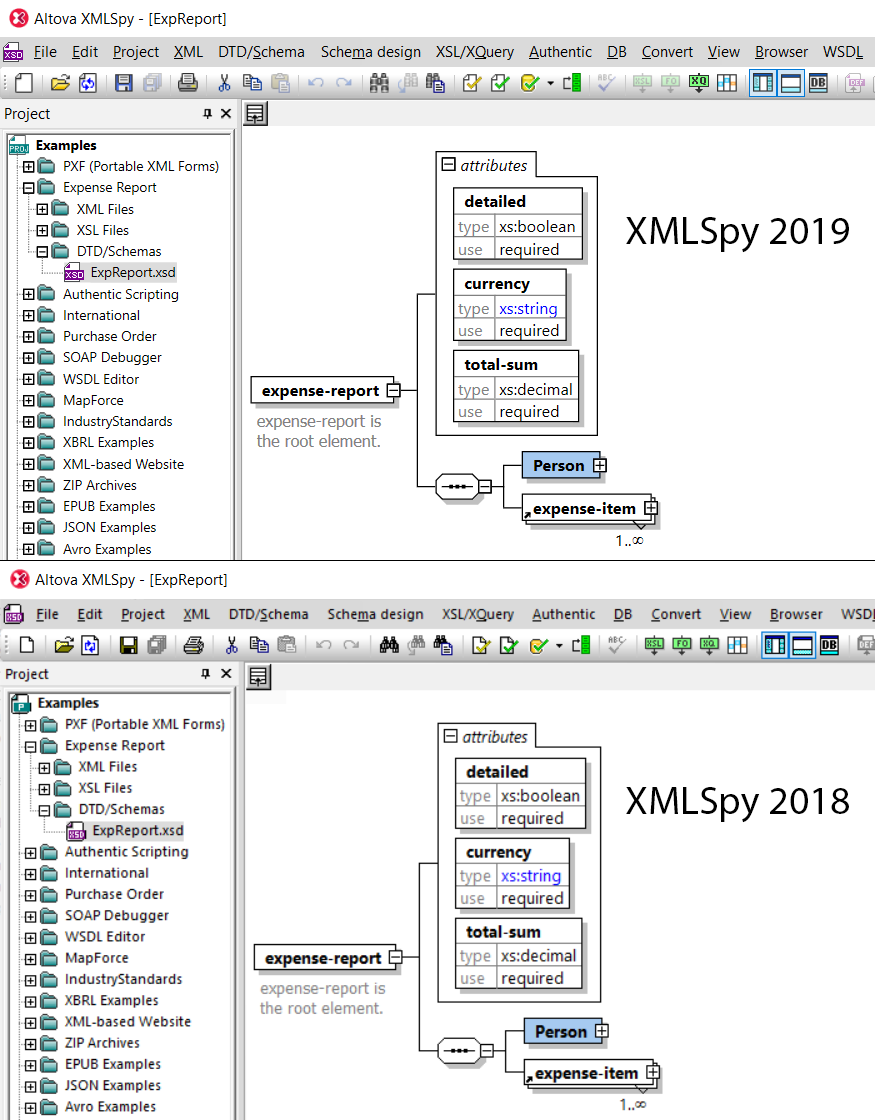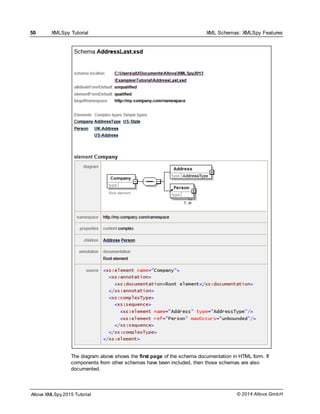

The central area provides you withmultiple views of your XML document. 2008 Altova GmbHAltova XMLSpy 2008 TutorialĢXMLSpy Tutorial1XMLSpy InterfaceXMLSpy InterfaceThe XMLSpy interface is structured into three vertical areas. These files supply the necessary data(namespaces and XML declarations) for you to start working with the respective XML documentimmediately.
#XMLSPY TUTORIAL LICENSE#
You can request a regular license fromour secure web server or through any one of our resellers.Tutorial example filesThe tutorial files are available in the application folder:C:\Documents and Settings\ username \My Documents\Altova\XMLSpy2008\Examples\TutorialThe Examples folder contains various XML files for you to experiment with, while theTutorial folder contains all the files used in this tutorial.The Template folder in the application folder contains all the XML template files that are usedwhenever you select the menu option File New. The evaluation version ofXMLSpy is fully functional but limited to a 30-day period.
#XMLSPY TUTORIAL FREE#
This involves assigning an XSLTfile and carrying out the transformation using XMLSpy's built-in XSLT engines.Working with XMLSpy projects, which enable you to easily organize your XMLdocuments.Installation and configurationThis tutorial assumes that you have successfully installed XMLSpy on your computer andreceived a free evaluation key-code, or are a registered user.
#XMLSPY TUTORIAL HOW TO#
You will learn how to assign a schema for an XMLdocument, edit an XML document in Grid View and Text View, and validate XMLdocuments using XMLSpy's built-in validator.Transforming an XML file using an XSLT stylesheet. You will learn how to create an XML Schema in XMLSpy'sintuitive Schema Design View, how to create complex content models usingdrag-and-drop mechanisms, and how to configure the Schema Design View.Using Schema Design View features to create complex and simple types, globalelement references, and attribute enumerations.Learning how to navigate schemas in Schema Design View, and how to generatedocumentation of schemas.Creating an XML document. Inthe process you will learn how to use some of XMLSpy's most powerful features.The tutorial is divided into the following parts: Creating an XML Schema. XMLSpy Tutorial1XMLSpy TutorialThis tutorial provides an overview of XML and takes you through a number of key XML tasks. XSL File647Project Management7.1Benefits of Projects. Schema596XSLT Transformations6.1Assigning an XSLT.File626.2Transforming the.XML File636.3Modifying the. Document495.6Appending Elements.and Attributes in Grid View535.7Editing in Database/Table.View555.8Modifying the. Type of an Element425.3Entering Data in.Grid View445.4Entering Data in.Text View455.5Validating the.

355XML Documents5.1Creating a New.XML File405.2Specifying the. Attribute Enumerations294XML Schemas: XMLSpy Features4.1Schema Navigation. 72.3Defining a Content.Model82.4Adding Elements.with Drag-and-Drop122.5Configuring the.Content Model View132.6Completing the.Basic Schema153XML Schemas: Advanced3.1Working with Complex.Types and Simple Types193.2Referencing GlobalElements.273.3Attributes and. Table of Contents1XMLSpy Interface22XML Schemas: Basics32.1Creating a New. In no event shall the publisher and the author beliable for any loss of profit or any other commercial damage caused or alleged to havebeen caused directly or indirectly by this document.Published: 2008 2008 Altova GmbH
#XMLSPY TUTORIAL CODE#
The publisher and the author make no claim tothese trademarks.While every precaution has been taken in the preparation of this document, the publisherand the author assume no responsibility for errors or omissions, or for damages resultingfrom the use of information contained in this document or from the use of programs andsource code that may accompany it. No parts of this work may be reproduced in any form or by any means- graphic, electronic, or mechanical, including photocopying, recording, taping, orinformation storage and retrieval systems - without the written permission of the publisher.Products that are referred to in this document may be either trademarks and/or registeredtrademarks of the respective owners.

Altova XMLSpy 2008 TutorialAll rights reserved.


 0 kommentar(er)
0 kommentar(er)
